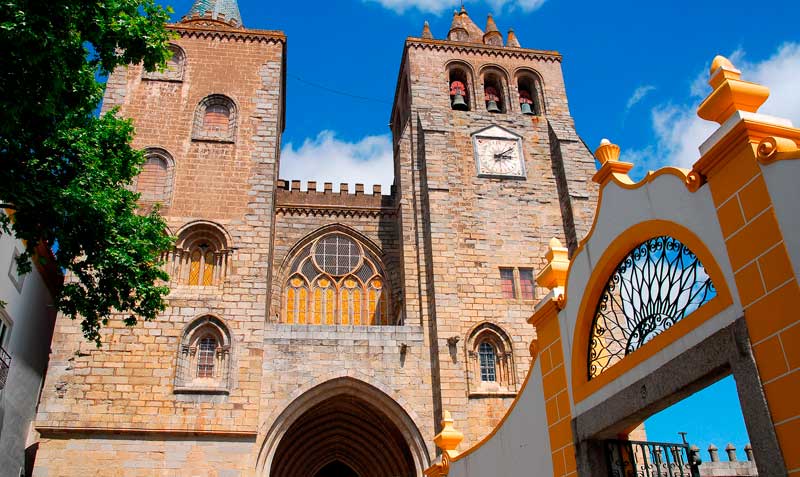If you’re looking to figure out what to see in Evora, search no more! We’ve prepared a simple guide. If you think you’ll probably have a few things to see in Évora you are absolutely… Wrong! There are many places to visit in Évora.
What to see in Evora
Évora is a UNESCO World Heritage site due to its well-preserved old town centre, still partially enclosed by medieval walls, and many monuments dating from various historical periods.
Situated in Alentejo, Évora is a large region of wide plains on the south of Portugal, with border on the North by the Tagus River and on the South by the region of Algarve. The city is 140 km (87 mi) from the capital city Lisbon.
3 major attractions to see in Evora

Bones Chapel
This Chapel is one of the most popular monuments in Évora and one of the highlights that can’t be missed! Built in the 17th century with the aim to show the temporariness and fragility of human life. At its entrance you’ll find the inscription “We bones that are here, for yours we wait”.
In total, there are around 5000 human skulls in Bones Chapel. Even though looks scary, the Chapel was constructed out of necessity. During the 16th Century, the graveyards in Evora were overcrowded and because of that bones had to be exhumed. Therefore, the bones were respectfully cast into the cement of this house of worship.

Roman Temple
The Temple, constructed around the first century AD, represents one of the most significant landmarks relating to the Roman and Lusitanian civilizations of Évora and in Portuguese territory. This is why it was classified by UNESCO as a World Heritage Site.
The first references to the ‘Temple of Diana’ began to appear in the 17th century. However, history reveals that, in reality, the Evora Roman Temple was built to pay tribute to Emperor Augustus, worshiped as a god. Through the years the temple was modified and partly destroyed but in the 19th century there was a major restoration, with the objective of giving the temple the original lines back, its dignity as a monument.

Cathedral of Évora
Built between 1186 and 1250, it is the largest medieval cathedral in Portugal, entirely made of granite. The transition from the Romantic to the Gothic determines its style.
Dedicated to the Virgin Mary, the Cathedral was constructed on the site of an important Mosque, as a symbolic act to the 12th century crusaders.
The most historically important event occurred was the blessing of Vasco da Gama’s fleets flags before his famous expedition to India.
To have the best view over Evora, visit the terrace of this World Heritage Site by UNESCO.
Places you can’t miss to see in Évora

Giraldo Square
This famous square marks the centre of the city. In fact, all the streets in Évora lead there.
Giraldo Square is a tribute to Fearless Geraldo Geraldes, the man who conquered Evora from the Moors in 1167. In order to thank him King Afonso Henriques, the first king of Portugal, nominated him Governor of Evora and High Protector of the Borders of Alentejo.
This baroque style fountain made of marble dates from 1570. With 8 spouts, each one symbolises one of the main streets from and to Giraldo Square.

Cromlech of the Almendres
The Cromlech of the Almendres is a megalithic complex, located near the village of Nossa Senhora de Guadalupe, near Évora, and actually the largest existing group of structured menhirs in the Iberian Peninsula. The construction, witch dates back to the 6th millennium BC, it is believed that either had a religious or ceremonial purpose.
Água de Prata Aqueduct
During the 16th century, the Aqueduct of Água da Prata (witch translated means Silver Water) was the most important hydraulic structure built in Portugal. It’s a Portuguese National Monument since 1910, and considered one of the most impressive monuments in the city.
However, the solution to ensure a proper and regular supply of public water to the city it was found in 1873. This conservation works gave the Aqueduct its current appearance.
The Aqueduct still fulfils its function today, contributing to the flow of water supply the city of Évora.
University of Évora
The University of Évora is a public university and the second oldest in the country. Established in 1559, received a University status on the same year by Pope Paul IV. Running under the aegis of the Society of Jesus (also known as Jesuits), the university was a target of the oppression. For that reason it was closed down in 1779 and its masters either incarcerated or exiled.
The University reopened nearly two hundred years later, in 1973, as University Institute of Évora as part of a set of education policies during the early 1970s. Six years later, in 1979, the name was changed to University of Évora (in Portuguese Universidade de Évora).
Cadaval Palace
The Cadaval Palace has been the home and the property of the Dukes of Cadaval family since its foundation in the 14th century until today. The church and some of the rooms are open to the public, exhibiting rare items, for instance: books, charters, arms, paintings, sculptures, furniture, porcelain and portraits, among other objects of value and major historical interest.
Built on the ruins of a Moorish castle, the result is a unique combination of Gothic and Manueline styles. It is one of the greatest historic sights of Evora, once used by the governor of the city and served, from time to time, as royal residence.
This is not all you can see in Evora
There is still so much more you can see in Evora. To sum up, here you have a small list of other sites:
- Public garden of Évora
- São Francisco Church
- Cartuxa Convent
- Museum of Évora
- Church of Santo Antão
- Watch Museum
- Church of Lóios
- São Brás Hermitage
- Roman Ruins – Baths
- Santa Clara Convent
- Porta de Aviz
- Nossa Senhora da Graça
Therefore, if you’re planning to visit Évora and want to explore properly this beautiful city, we’ll be happy to tailor your tour! If you have limited time, check or One Day Tour Evora and Monsaraz with pick up in Lisbon.
To be updated about the wonders of Portugal, follow us on instagram!

